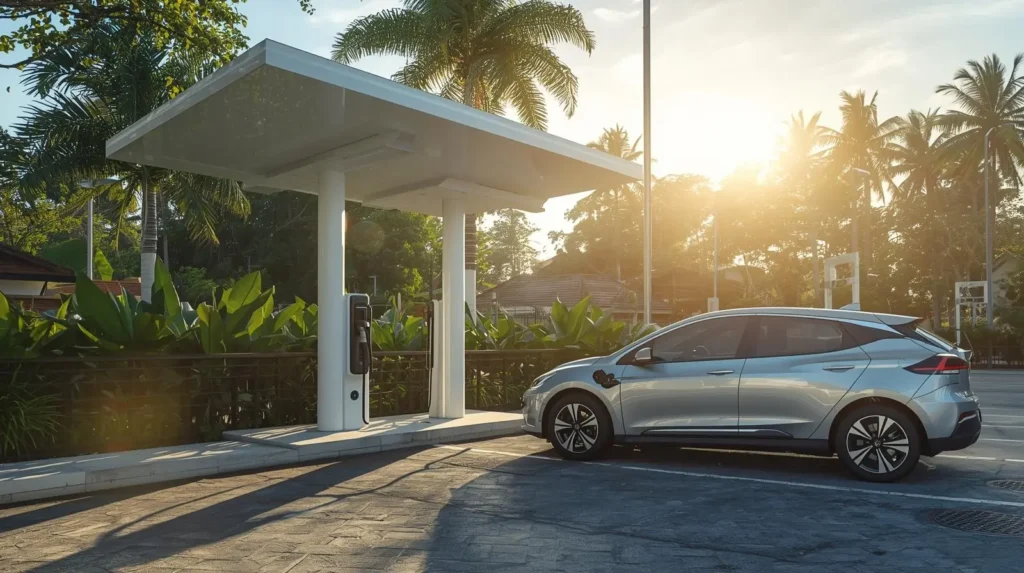
Battery as a Service (BaaS): The electric vehicle (EV) market is growing fast. New ideas are making EV ownership more affordable and easier.
One such idea is Battery as a Service (BaaS). This model lets you lease EV batteries instead of buying them. It lowers costs and gives more flexibility to EV owners.
In this guide, we will explore what BaaS is, how it works, its benefits, challenges, and future potential.
What is Battery as a Service (BaaS)?
Battery as a Service is a subscription model for EV batteries. EV owners can lease batteries instead of owning them. This allows users to swap their batteries at special stations when needed.
How Battery as a Service (BaaS) Works?
Battery as a Service works on several models including:
- Subscription Model: EV owners pay monthly fees for battery use. Costs depend on battery size and how much it is used.
- Battery Swapping Stations: Swapping stations allow users to exchange empty batteries for charged ones. This process takes only a few minutes.
- Battery Management: Providers take care of battery maintenance and recycling. They make sure batteries work well and last longer.
- Flexible Options: Some companies let you adjust your plan. You can upgrade or downgrade based on how much range you need.
The Potential of Battery as a Service (BaaS)
Battery as a Service (BaaS) is transforming electric vehicle (EV) ownership by separating battery costs from the vehicle. Through a subscription model, users can swap depleted batteries for fully charged ones in minutes, addressing key EV adoption barriers.
BaaS significantly reduces upfront EV costs, making them more accessible. It eases range anxiety by offering quick battery swaps and provides a practical charging solution for urban areas without home charging infrastructure.
Additionally, Battery as a Service supports the energy ecosystem by using idle batteries to stabilize power grids and enabling battery recycling and reuse.
This model is particularly promising for fleet vehicles like taxis and rentals, which operate in confined areas and require minimal infrastructure.
With proper investment, government support, and collaboration between manufacturers and technology providers, BaaS could complement traditional charging models, creating a flexible, efficient ecosystem.
While challenges like battery standardization and raw material dependencies exist, BaaS has the potential to revolutionize EV ownership, making it faster, more affordable, and more sustainable.
Also Read: How Does the Combined Charging System (CCS) Work?
Why is Battery as a Service (BaaS) Gaining Attention?
The idea of separating batteries from vehicles is not new. It started in 2007 but did not become popular back then. Now, with better EV technology and more EVs on the road, BaaS is becoming popular again.
Benefits of Battery as a Service (BaaS)
BaaS has many benefits for both consumers and the environment.
1. Lower Upfront Costs
The battery is the most expensive part of an EV. Leasing the battery lowers the vehicle’s purchase price.
Example: If an EV costs $40,000 with the battery, BaaS can lower the cost to $30,000. You only pay a monthly fee for the battery.
2. Solves Range Anxiety
Many people worry their EV will run out of power before reaching their destination. BaaS solves this by making battery swapping fast and easy.
Efficiency: Battery swapping takes only 3 minutes. Charging at stations takes at least 30 minutes.
3. Flexible Energy Needs
BaaS lets users adjust their battery size based on their trips.
- Daily Use: Choose smaller batteries for short trips.
- Long Trips: Upgrade to bigger batteries for vacations or long journeys.
4. Better Battery Care
BaaS providers handle battery health and maintenance.
- Monitoring: Providers monitor battery performance to ensure reliability.
- Recycling: Old batteries are reused or recycled, reducing waste.
5. Supports Renewable Energy
BaaS can help use more renewable energy.
- Charging Stations: Swapping stations can use solar or wind power.
- Grid Stability: Batteries can store extra energy and release it during peak hours.
Challenges of Battery as a Service (BaaS)
BaaS faces several challenges before it can become common. Its challenges are as follows:
1. Standardization Problems
Different EV brands use different batteries. Without standard batteries, swapping stations cannot serve all EVs.
2. High Setup Costs
Building battery-swapping stations is expensive. Companies need to invest in technology, space, and staff.
3. Consumer Trust Issues
Some people may not trust leasing batteries. They might worry about reliability or long-term costs.
4. Government Rules
BaaS companies must follow energy and transportation rules. These rules differ by region, creating more hurdles.
The Future of Battery as a Service (BaaS)
BaaS has great potential. With more investment and better technology, it could become a key part of EV ownership.
1. Advanced Battery Technology
New types of batteries, like solid-state batteries, are being developed. These batteries are safer and store more energy.
2. More Investment in Infrastructure
Governments and companies are funding BaaS projects. This will help expand battery-swapping networks.
3. Focus on Fleet Operations
Businesses like delivery companies and ride-sharing services could benefit most from BaaS. Leasing batteries could lower their costs.
4. Global Expansion
Countries like China are leading the way with BaaS. For example, NIO, a Chinese EV company, has done over 10 million battery swaps. Other countries are also exploring similar solutions.
Also Read: Everything About Fast EV Charging Technology
Let’s Wrap Up
Battery as a Service (BaaS) is an exciting innovation. It lowers the cost of owning an EV and makes battery management easier. While challenges remain, BaaS has the potential to revolutionize the EV market. With growing investments and technology improvements, EVs could be made more accessible worldwide.
BaaS is not just about saving money; it is also about creating a sustainable and flexible future for transportation.



